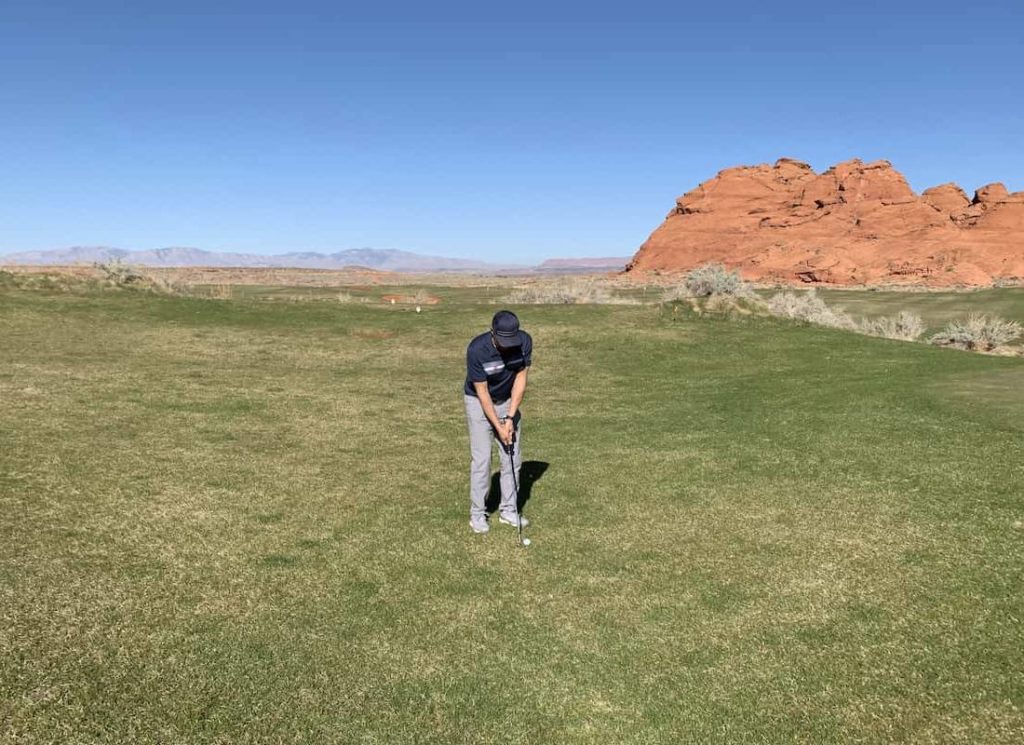Players always get confused on the terminology of chipping and pitching (chipping is when the ball rolls farther than it flies, pitching is when the ball flies farther than it rolls). This post will focus on chipping but please check out my Golf Pitching 101 post next.
I like to equate chipping to bowling. You never want to throw your bowling ball down the lane in the air as long as you can because you will lose the accuracy and speed needed to knock down the pins. This means that if you want more control of the ball, I recommend rolling the bowling ball closer to the ground and releasing the ball from there. So in chipping, we want to get the golf ball on the green earlier and let the ball roll from there.
Whenever we chip, we usually do from around the collar of the green. The golf ball could be on the fringe/collar of the green or just off into the rough. Our goal is to chip the ball with little carry and to let the ball roll to the hole from there.
There is no exact distance that separates what is chipping and pitching but we do approach the shot in the same manner. I tell my students that chipping is more of an “art-form.” There are many factors you have to go over in your mind before you make that chip. When I miss a green and survey my ball, this is what I quickly think about to carry my decision and envision the perfect chip.
Survey Your Chipping Situation
Check the Lie of the Golf Ball
Is it on the short grass (fringe or collar) or is the golf ball in the rough? If it’s in the rough, is the golf ball lying in high or short grass rough? Is the golf ball lying in dense grass or thin bare rough? Is it sitting down in the rough or is it more on top of the rough? We want to envision how the club will go through the rough so can make better contact with the golf ball to the clubface.
Check Hole Location On the Green
Next you’ll want to check the location of the hold on the green and compare it to where your ball lies. You want to see how much green you have to work with. This means if the hole is closer to you, you will have less green distance to chip the ball on and have it roll out. If the hole location is on the further part of the green, you will use the green distance and take advantage of rolling the ball more towards the hole than carrying it in the air.
Decide What Club You Will Use
Using the first two factors, you will have to decide what club would be best to make consistent contact with the golf ball and how you want the golf ball to approach the green. Would you want it to come in a bit higher which means more backspin and less roll or would you want it to land on the green more shallow and roll more?
Understand your Wedges
It seems simple but let’s make sure you understand why there are multiple golf wedges.
What Grip Should I Use?
Most players will use their regular grip from the full swing for chipping no matter what club you will be using. Just make sure the grip pressure stays light throughout the swing so you can still feel the clubhead and momentum through impact.
There is one exception: you can change your grip to your putting grip (palms face each other more and down your target line) and that’s usually when you are in a situation when you will use a hybrid/fairway wood off the collar somewhere. This would keep the ball more along the ground and keep the clubface and path more down the target line like putting. I have used it when the ball is against the edge of the rough when you are on the collar. The deeper face at the bottom of these clubs will make more impact with the ball more than the rough.
Chipping Stance
The chipping stance is very important and most commonly wrong when someone has trouble chipping. I tell my students that chipping can be similar to putting but with a different stance using a different club.
When I see a chipping stance, I want to see my student finish their stroke before they even start it. This means that let’s get in a stance that we usually finish with so we can eliminate movement of the body on the way back. We also want to do this so we can create a steeper/sharper angle that the club will make more impact with the ball even if it’s in the rough.
- Choke down on the club a bit. Everyone is different but you will have a better feel of the clubhead.
- When the club is shorter, this will allow you to get closer to the ball
- Turn your entire body a bit open to where your toes are pointing a bit in front of the ball.
- Lean to the target and put more weight and slight more bend on your forward leg
- Hands will not be in front of forward thigh with shaft lean
- Ball will now be more on your right side of body
- Relax shoulders and arms / elbows may feel that they are poking out a bit
Chipping Stroke
When using the proper stance, your set-up should feel like you are angled differently to the ball. The ball position to your stance will make you feel that you will make contact with the golf ball more on a downward stroke.
This stroke is made with shoulders and upper body only but you still must feel the clubhead heavy throughout so you can still feel the release of the clubhead through impact. For players that use their hands more than the body, it will feel more like a putting stroke where it will be a stroke with better tempo and not rushed.
Your hands and grip will always be ahead of the clubhead through the stroke until they almost finish together after contact with the golf ball. This happens when your body and legs slightly rotate through impact to hold your wrist angle to prevent from flipping/using your hands to make contact.
Chipping Follow-Through
If you started your swing with an open stance, the follow through is all about holding the wrist angles after impact. In order to do this, you will need to make sure the body slightly rotates with the club after impact. The hips and legs will react to this movement by also moving with the momentum.


